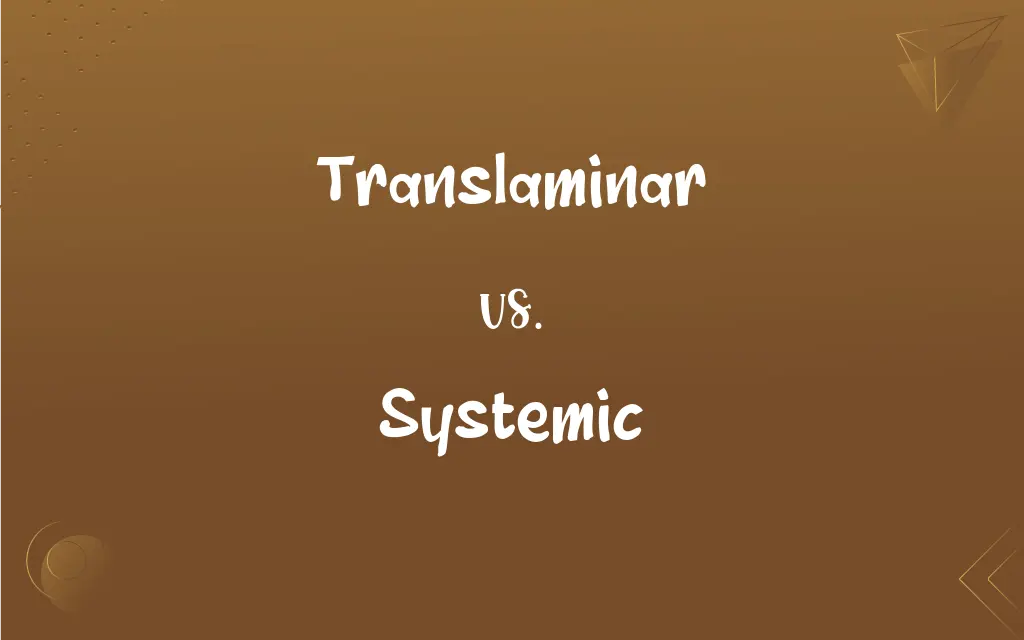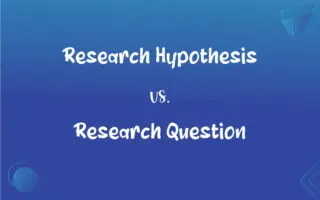Translaminar vs. Systemic: What's the Difference?
Edited by Aimie Carlson || By Janet White || Published on March 4, 2024
Translaminar pesticides move across leaf tissues, providing localized protection; systemic pesticides are absorbed and distributed throughout a plant, offering widespread defense.

Key Differences
Translaminar pesticides are those that, when applied to the surface of a plant, can penetrate and move across the leaf tissues to provide protection on both sides of the leaf without necessarily being absorbed into the plant’s vascular system. This action allows for the control of pests that may attack the parts of the plant that have not been directly treated. Systemic pesticides, in contrast, are absorbed by the plant and transported throughout its tissues, via the vascular system, offering protection against pests by making the entire plant toxic to them.
The effectiveness of translaminar pesticides is largely dependent on their ability to reach the pest through the movement across the plant tissues; they are particularly useful for targeting pests that reside on the underside of leaves or within the plant but do not affect the pests that do not come into contact with the treated surfaces. Systemic pesticides are effective against a broader range of pests, including those that feed on the plant’s sap, as the pesticide is present throughout the plant's tissues.
Translaminar products are often favored for their targeted action and reduced impact on non-target organisms, since their reach is limited to the treated plant tissues. However, their protection is somewhat localized and may not last as long as systemic products. Systemic pesticides offer longer-lasting protection and can protect new growths of the plant, as the pesticide is transported to new leaves and stems as the plant grows.
The application method differs significantly between the two: translaminar pesticides may only require surface application, whereas systemic pesticides might need soil application or injection into the plant to ensure absorption and distribution throughout the plant. The choice between translaminar and systemic pesticides depends on the specific pest problem, the type of plants being treated, and the environmental considerations of pesticide use.
Comparison Chart
Movement in Plant
Moves across leaf tissues
Absorbed and distributed throughout the plant
ADVERTISEMENT
Protection
Localized on treated surfaces
Whole plant protection
Target Pests
Pests on or near treated areas
Broad range, including sap-feeders
Duration of Effectiveness
Generally shorter
Longer-lasting
Application Method
Surface application
Soil application or plant injection
Translaminar and Systemic Definitions
Translaminar
Crosses the leaf barrier to protect non-treated sides.
The gardener chose a translaminar insecticide for its focused efficacy.
ADVERTISEMENT
Systemic
Absorbed and circulated through a plant’s vascular system.
Systemic herbicides kill weeds by disrupting their internal processes.
Translaminar
Acts on surface-applied areas, crossing to untreated sides.
Translaminar products are ideal for foliar diseases affecting lower leaf surfaces.
Systemic
Provides whole-plant protection from pests and diseases.
After treating the soil, the systemic insecticide protected the entire plant from aphids.
Translaminar
Penetrates leaf tissues for localized protection.
The translaminar spray effectively reached pests on the leaf’s underside.
Systemic
Effective against a broad range of internal and external pests.
Systemic fungicides are used to prevent diseases that affect the plant's vascular system.
Translaminar
Moves through layers of leaf without systemic absorption.
Applying translaminar fungicides protects both sides of the leaf.
Systemic
Ensures protection to new growths and internal tissues.
Systemic pesticides safeguard the plant as it grows, reaching new leaves and stems.
Translaminar
Offers targeted pest control within leaf tissues.
Translaminar action helps conserve beneficial insects by targeting only affected areas.
Systemic
Of or relating to systems or a system.
Translaminar
Across or through a lamina
Systemic
Relating to or affecting the entire body or an entire organism
Systemic symptoms.
A systemic poison.
Translaminar
Through a leaf, from one surface to the other
Systemic
Relating to or affecting a particular body system, especially the nervous system
A systemic lesion.
Systemic
(Physiology) Of or relating to systemic circulation.
Systemic
Embedded within and spread throughout and affecting a whole system, group, body, economy, market, or society.
Systemic
(physiology) Pertaining to an entire organism.
Systemic
Of or relating to a system; common to a system; as, the systemic circulation of the blood.
Systemic
Of or pertaining to the general system, or the body as a whole; as, systemic death, in distinction from local death; systemic circulation, in distinction from pulmonic circulation; systemic diseases.
Systemic
Affecting an entire system;
A systemic poison
Systemic
Absorbed by roots or leaves and transported throughout the plant.
The systemic treatment was applied to the soil to combat root nematodes.
FAQs
What is a systemic pesticide?
A pesticide absorbed and circulated by the plant’s vascular system for comprehensive protection.
What does translaminar mean?
Refers to pesticides that move across leaf tissues but not throughout the plant.
What pests are systemic pesticides effective against?
Effective against a wide range, including those feeding on sap or internal tissues.
How do translaminar pesticides work?
They penetrate and protect both sides of the leaf without being fully systemic.
Do systemic pesticides affect beneficial insects?
They can, as any insect feeding on the plant may be affected.
How long do translaminar pesticides last?
Their effectiveness is generally shorter than systemic pesticides.
Can translaminar and systemic pesticides be used together?
Yes, for comprehensive pest management strategies.
Can translaminar products protect new plant growths?
No, their protection is limited to treated tissues only.
Are systemic pesticides safe for all plants?
Generally, but specific plant sensitivity and pesticide label instructions should be followed.
What safety precautions are necessary when using systemic pesticides?
Wear protective clothing and follow label instructions to prevent exposure.
How do environmental conditions affect translaminar efficacy?
Rainfall and irrigation can reduce their effectiveness by washing them off.
What are the environmental considerations for using systemic pesticides?
Potential impact on non-target species and groundwater contamination must be considered.
What application methods are used for translaminar pesticides?
Typically sprayed directly onto the plant surface.
Are systemic pesticides resistant to environmental wash-off?
Yes, once absorbed, they are less likely to be washed away.
How do you determine the need for translaminar versus systemic treatment?
Based on pest type, plant species, and desired protection scope.
Can translaminar treatments reach pests inside the plant?
Only if the pest is in direct contact with the treated area or just across the leaf tissue.
What is the main advantage of systemic over translaminar pesticides?
Systemic pesticides offer comprehensive and longer-lasting protection.
How does plant type influence the choice between translaminar and systemic treatments?
Plant size, growth habit, and pest type can determine the most effective treatment.
How are systemic pesticides applied?
Through soil application, injection, or foliar sprays that are absorbed.
Do systemic treatments require frequent reapplication?
Less frequently than translaminar, due to their prolonged effectiveness.
About Author
Written by
Janet WhiteJanet White has been an esteemed writer and blogger for Difference Wiki. Holding a Master's degree in Science and Medical Journalism from the prestigious Boston University, she has consistently demonstrated her expertise and passion for her field. When she's not immersed in her work, Janet relishes her time exercising, delving into a good book, and cherishing moments with friends and family.
Edited by
Aimie CarlsonAimie Carlson, holding a master's degree in English literature, is a fervent English language enthusiast. She lends her writing talents to Difference Wiki, a prominent website that specializes in comparisons, offering readers insightful analyses that both captivate and inform.







































































